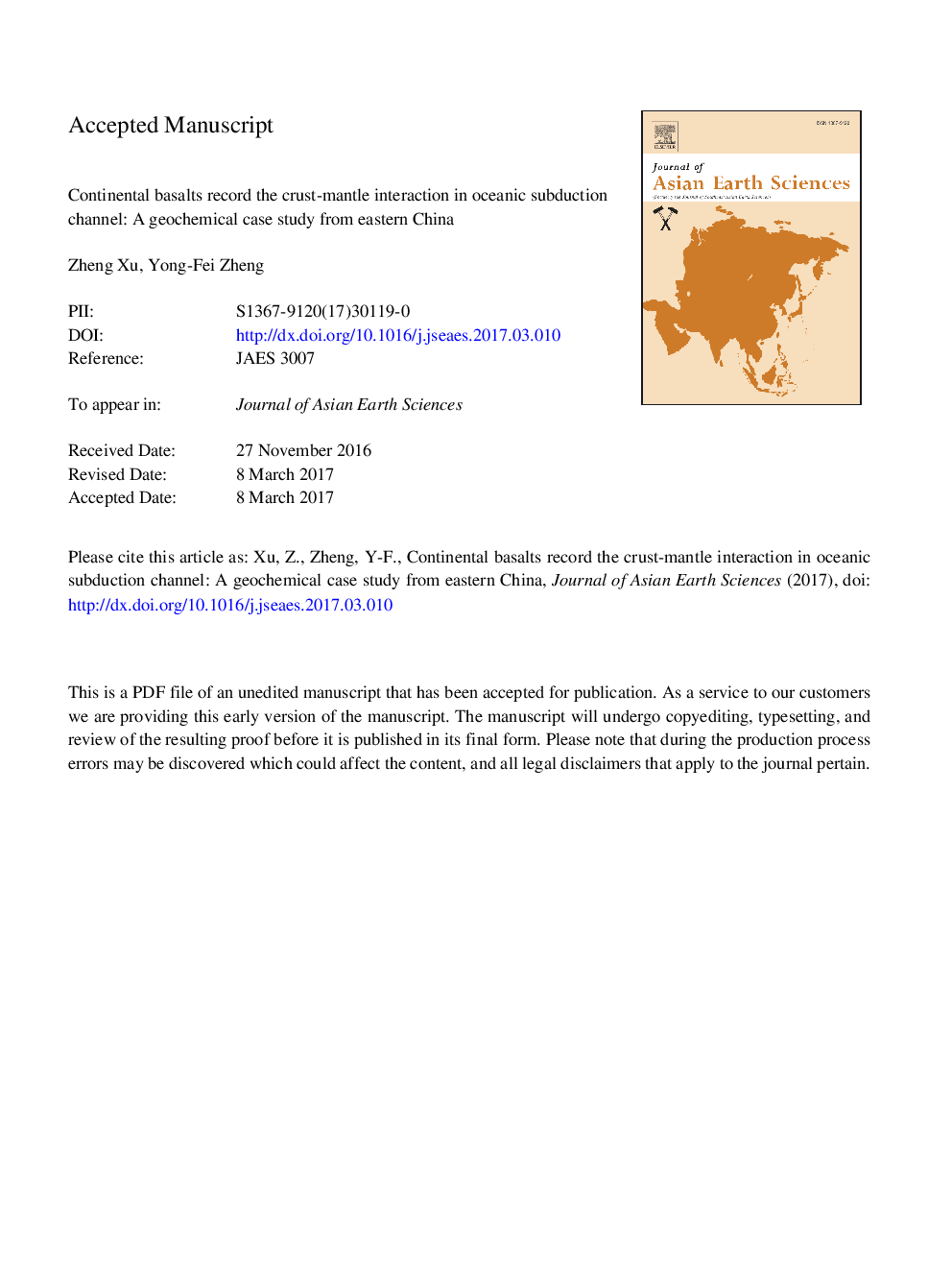| کد مقاله | کد نشریه | سال انتشار | مقاله انگلیسی | نسخه تمام متن |
|---|---|---|---|---|
| 5785960 | 1414092 | 2017 | 83 صفحه PDF | دانلود رایگان |
عنوان انگلیسی مقاله ISI
Continental basalts record the crust-mantle interaction in oceanic subduction channel: A geochemical case study from eastern China
ترجمه فارسی عنوان
بازالت های قاره ای تعامل پوسته پوسته و گوشته را در کانال فرورانش اقیانوس ثبت می کنند: یک مطالعه موردی ژئوشیمیایی از شرق چین
دانلود مقاله + سفارش ترجمه
دانلود مقاله ISI انگلیسی
رایگان برای ایرانیان
کلمات کلیدی
بازالت قاره ای، منابع گوشتی اسلب اقیانوسی، کانال فرابنفش متاسوماتیزم خردل،
موضوعات مرتبط
مهندسی و علوم پایه
علوم زمین و سیارات
زمین شناسی
چکیده انگلیسی
Continental basalts, erupted in either flood or rift mode, usually show oceanic island basalts (OIB)-like geochemical compositions. Although their depletion in Sr-Nd isotope compositions is normally ascribed to contributions from the asthenospheric mantle, their enrichment in large ion lithophile elements (LILE) and light rare earth elements (LREE) is generally associated with variable enrichments in the Sr-Nd isotope compositions. This indicates significant contributions from crustal components such as igneous oceanic crust, lower continental crust and seafloor sediment. Nevertheless, these crustal components were not incorporated into the mantle sources of continental basalts in the form of solidus rocks. Instead they were processed into metasomatic agents through low-degree partial melting in order to have the geochemical fractionation of the largest extent to achieve the enrichment of LILE and LREE in the metasomatic agents. Therefore, the mantle sources of continental basalts were generated by metasomatic reaction of the depleted mid-ocean ridge basalts (MORB) mantle with hydrous felsic melts. Nevertheless, mass balance considerations indicate differential contributions from the mantle and crustal components to the basalts. While the depleted MORB mantle predominates the budget of major elements, the crustal components predominate the budget of melt-mobile incompatible trace elements and their pertinent radiogenic isotopes. These considerations are verified by model calculations that are composed of four steps in an ancient oceanic subduction channel: (1) dehydration of the subducting crustal rocks at subarc depths, (2) anataxis of the dehydrated rocks at postarc depths, (3) metasomatic reaction of the depleted MORB mantle peridotite with the felsic melts to generate ultramafic metasomatites in the lower part of the mantle wedge, and (4) partial melting of the metasomatites for basaltic magmatism. The composition of metasomatites is quantitatively dictated by the crustal metasomatism through melt-peridotite reaction at the slab-mantle interface in oceanic subduction channels. Continental basalts of Mesozoic to Cenozoic ages from eastern China are used as a case example to illustrate the above petrogenetic mechanism. Subduction of the paleo-Pacific oceanic slab beneath the eastern edge of Eurasian continent in the Early Mesozoic would have transferred the crustal signatures into the mantle sources of these basalts. This process would be associated with rollback of the subducting slab at that time, whereas the partial melting of metasomatites takes place mainly in the Late Mesozoic to Cenozoic to produce the continental basalts. Therefore, OIB-like continental basalts are also the product of subduction-zone magmatism though they occur in intraplate settings.
ناشر
Database: Elsevier - ScienceDirect (ساینس دایرکت)
Journal: Journal of Asian Earth Sciences - Volume 145, Part A, 1 September 2017, Pages 233-259
Journal: Journal of Asian Earth Sciences - Volume 145, Part A, 1 September 2017, Pages 233-259
نویسندگان
Zheng Xu, Yong-Fei Zheng,
